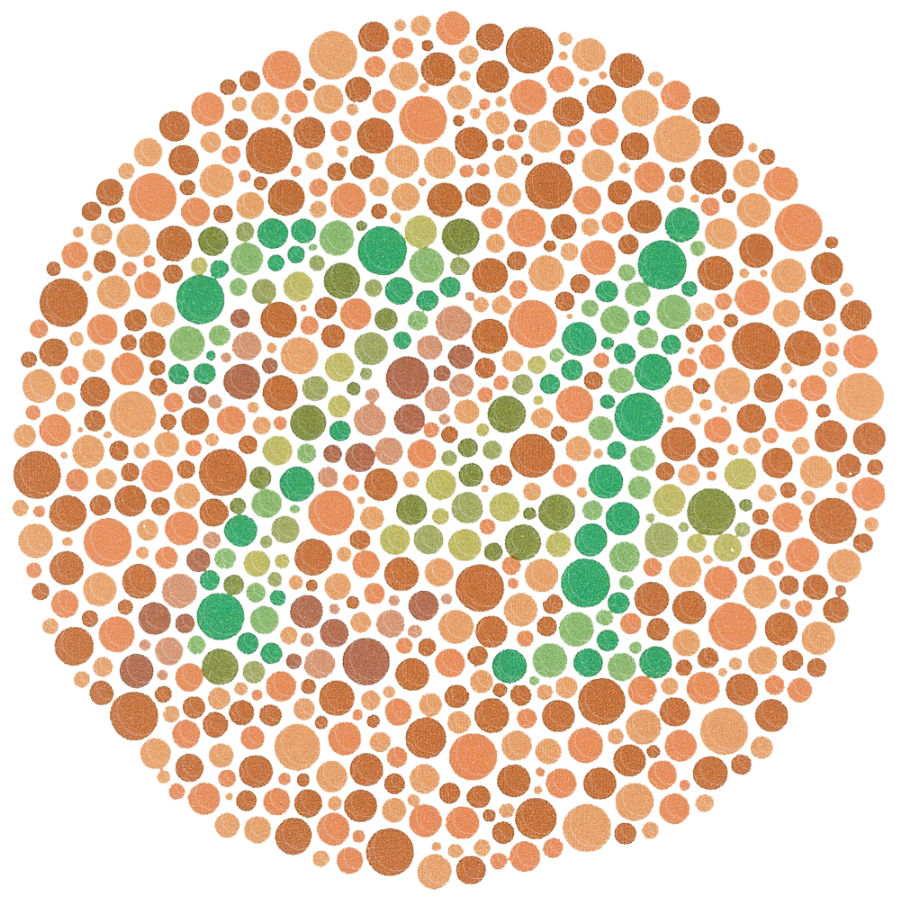Color Blindness
What is color blindness?
Color blindness, less commonly but more accurately known as color vision deficiency, is the decreased ability to see color or differences in color. People with total color blindness, however, may also have decreased visual acuity and be uncomfortable in bright environments.
The most common cause of color blindness is an inherited fault in the development of one or more of the three sets of color sensing cones in the eye. A persons with XY chromosomes is more likely to be color blind than a persons with XX chromosomes, as the genes responsible for the most common forms of color blindness are on the X chromosome. For people with two X chromosomes, a defect in one is typically compensated for by the other versus people with only one X chromosome. Color blindness can also result from physical or chemical damage to the eye, optic nerve, or parts of the brain. Diagnosis is typically with the Ishihara color test (open example of an Ishihara color plate); however a number of other testing methods also exist.
There is no cure for color blindness although special lenses may help people with red–green color blindness when under bright conditions. There are also mobile apps that can help people identify colors.
Red/Green Deficiencies
The most common broad category of color-blindness is often called red-green color-blindness, but this does not mean that these people cannot see reds or greens. They simply have a harder time differentiating between them. Not all reds and greens are indistinguishable. It may be easy for someone with a red-green deficiency to tell the difference between a light green and a dark red, for example. A lot depends—at least in part—on how dark the colors are. If the red is approximately as dark as the green, there is a greater likelihood that the colors will be confused.
Also, there is some evidence that people with red-green color-blindness see reds and greens as yellows, oranges and beiges. This means that yellows, oranges, and beiges can be confused with greens and reds.
- Deuteranomaly and Deuteranopia (green deficiencies)
- Protanomaly and Protanopia (red deficiencies)
Blue/Yellow Deficiencies
Tritanopia is much less common than the other categories mentioned above. Tritanopia is the insensitivity to short wavelengths (the blues). In general blues and greens can be confused, but yellows are also affected in that they can seem to disappear or appear as lighter shades of red.
- Tritanomaly and Tritanopia (blue deficiencies)
Complete Color Blindness
This group constitutes an extremely small minority among people who are color-blind. The cones of the eye are non-functional, so the rods (receptors which can only differentiate between light and dark) are the only available source of visual information. Individuals with achromacy see no color at all. Theirs is a world of black, white, and shades of gray. They often have poor visual acuity and have an aversion to bright light. This is the only group for which "color-blindness" is a label that fits, since all other groups have the ability to see some color.
- Achromatomaly (unable to see almost any color)
- Achromatopsia (unable to see any color)
Examples
Designing and Coding for Color Vision Deficiencies
- Make sure that colors are not your only method of conveying important information.
- Make sure to meet minimum color contrast requirements.
Tools to Provide Examples of How Content Appears to Color Blind People
-
Spectrum - Chrome Browser Plug-In
Adds an icon to your browser allowing you to very quickly and easily toggle between various types of color vision deficiencies. -
Adobe Photoshop Soft-Proofing (Built-in Feature)
- Convert the document to RGB color mode, which provides the most accurate soft proofs for color blindness.
- To simultaneously view the original document and a soft proof, choose Window > New Window and arrange the windows for a side-by-side view (optional).
- Choose View > Proof Setup > Color Blindness, and then choose either Protanopia-type or Deuteranopia-type.
Frequently Asked Questions
Q. "But, how many people does this really affect?"
A. It affects a large percentage of the population. We have more people with color deficiencies visiting our sites than we have using Internet Explorer. Roughly 8% of men and 0.5% of women are affected. This is approximately 1 in 12 men and 1 in 200 women.
Q. "Which is the most common type?"
A. Deuteranomaly (5% of men, 0.35% of women) is by far the most common color vision deficiency, followed by Protanomaly (1.3% of men, 0.02% of women), Protanopia (1.3% of men, 0.02% of women), and Deuteranopia (1.2% of men, 0.01% of women). Other types of color blindness are very rare.
Sources/Further Reading
The following links open in a new tab.
 Pattern Library
Pattern Library




